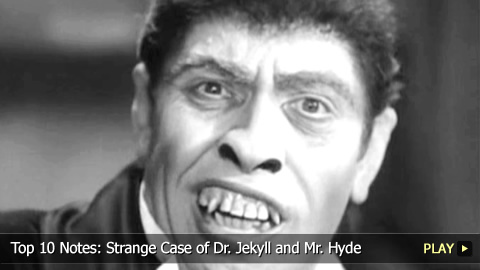Top 10 Notes: Strange Case of Dr. Jekyll and Mr. Hyde

When you think of split personalities, this 19th century tale is the first that comes to mind. Welcome to WatchMojo.com, and in this installment of Mojo Notes, we’ll be exploring ten pieces of trivia about Robert Louis Stevenson’s “Strange Case of Dr. Jekyll and Mr. Hyde.”
#10 – About the Author
Born in Edinburgh, Scotland in 1850, Robert Louis Stevenson was sick so often as a child he was mostly tutored privately. He loved writing stories, so his father helped him publish his first as a teen. Stevenson later built his writing reputation with books like “Treasure Island” and “Strange Case of Dr. Jekyll and Mr. Hyde.” Along with writing, he spent his last years involved in Samoan politics.
#9 – Influences and Inspirations
Though his childhood illness followed him into adulthood, it didn’t prevent Stevenson from writing his finest material. The author was said to have composed the “Strange Case of Dr. Jekyll and Mr. Hyde” novella while in bed in the early 1880s. His writing style incorporated elements of allegory, the gothic novel, detective stories, and Victorian literature.
#8 – Settings and Era
First published in 1886, the novella is set in late 19th century London, England. Known as the Victorian era, it was a time when people were expected to repress their true selves and feelings while conveying a more restrained and respectable exterior appearance. This made it the perfect setting and justification for Jekyll’s use of Hyde to live out his darker urges.
#7 – Plot
Told in the third person by an anonymous narrator, the plot follows John Utterson’s request to figure out what’s going on between his friend Dr. Henry Jekyll and a seemingly evil man named Edward Hyde. After witnessing several of Hyde’s crimes, Utterson attempts to confront Jekyll. But it’s only upon Dr. Hastie Lanyon’s death that Utterson realizes they must find out what is wrong with Jekyll. The truth is finally revealed when he finds a deceased Hyde in Jekyll’s clothing: Dr. Jekyll had been transforming into Hyde with a special potion so they were, in fact, the same person.
#6 – Mr. Gabriel John Utterson
The novella’s narrator focuses on Gabriel John Utterson, who is a London lawyer that represents Dr. Jekyll. Though he expresses few emotions, Utterson is a well-mannered and loyal gentleman who feels concern for his friends. This is what drives him to solve the mystery surrounding Jekyll and Hyde.
#5 – Dr. Henry Jekyll
Henry Jekyll is a 50-year-old doctor who is outgoing and well liked by his many friends. But he often feels like an imposter because he’s torn between his attempts to be good and his evil fantasies. This complex character tries to deal with the other side of his personality by creating a potion that lets him transform into someone else.
#4 – Mr. Edward Hyde
Edward Hyde represents the evil side of Jekyll’s personality. Considered his alter ego, he’s the person Jekyll transforms into after drinking a special serum. He’s physically smaller and younger than Jekyll and he awakens terror and disgust in others. His evil nature causes him to commit many crimes without feeling any guilt. Hyde’s power over Jekyll becomes so strong that Jekyll ultimately resorts to killing himself and Hyde in the process.
#3 – Values and Themes
The main theme of the “Strange Case of Dr. Jekyll and Mr. Hyde” is the inner struggle between good and evil, which was also a big preoccupation during the Victorian era. Other themes explored in the novella include friendship, repression, reputation, religion and science.
#2 – Modern Popularity
Because it touched upon so many of the Victorian era’s concerns and issues, the “Strange Case of Dr. Jekyll and Mr. Hyde” found popularity among bookworms and non-readers alike. It also sold tens of thousands of copies within half a year. The novella has since has pervaded pop culture across the globe in multiple formats.
#1 – Adaptations
The novella became so popular so quickly it was already being put to the stage one year after its initial publication. While there have been plenty of stage and radio adaptations, as well as spoofs, parodies and other pop culture appearances of “Jekyll & Hyde,” what’s more impressive are its over 100 film renditions. Well-known versions include the 1920 silent film and the 1931 take that won Fredic March an Oscar, as well as several television movies.
Do you agree with our list? What are your favorite pieces of “Strange Case of Dr Jekylland Mr Hyde” trivia? Be sure to subscribe to WatchMojo.com for more entertaining top 10s.

